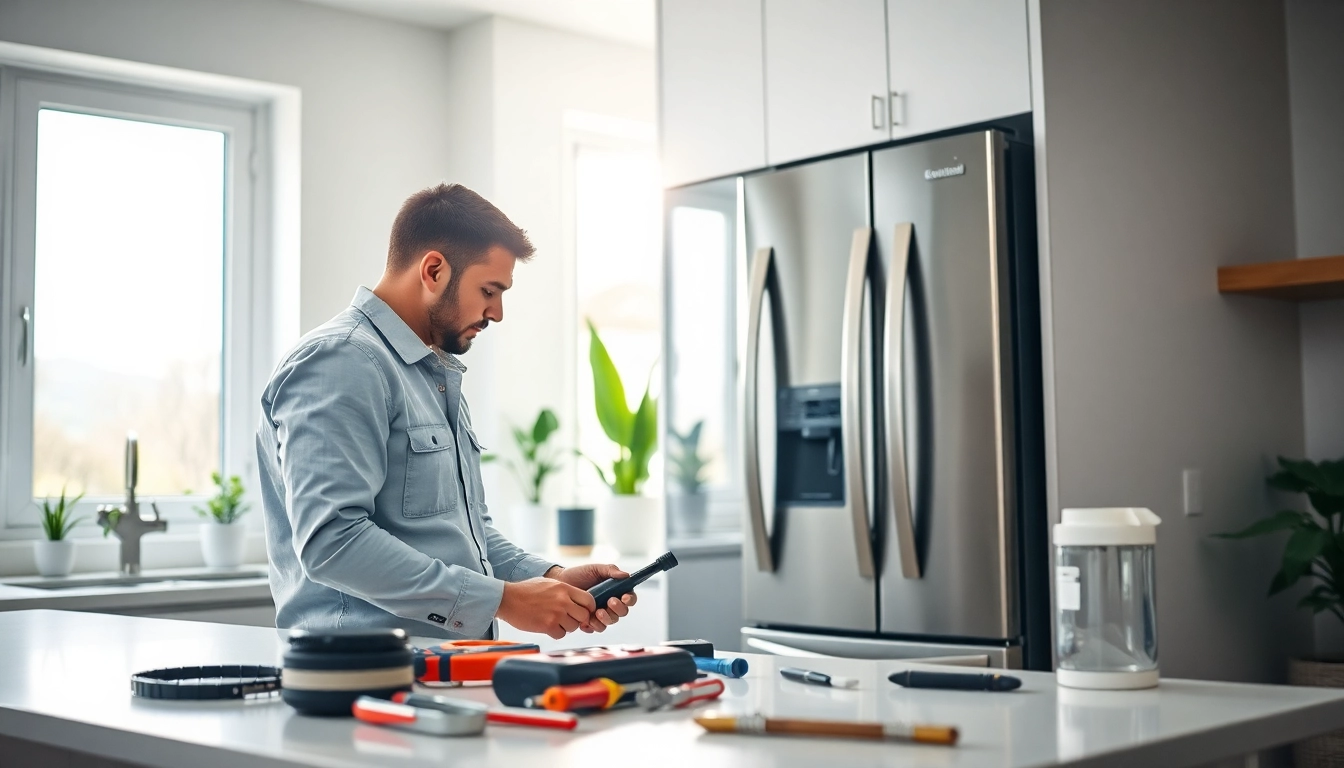Understanding Common Refrigerator Issues
Identifying Signs of Malfunction
Refrigerators are essential appliances that require regular maintenance to function effectively. However, various factors can lead to malfunctions. Recognizing the signs of an issue early can save you time and money. Common indicators that your refrigerator may be experiencing a problem include:
- Inconsistent temperatures: Food spoiling or freezing unexpectedly may indicate temperature regulation issues.
- Strange noises: Unusual sounds such as humming, buzzing, or rattling can signify mechanical problems within the unit.
- Excessive condensation: If moisture accumulates on the exterior or interior parts of your refrigerator, this may point to a failing seal or a malfunctioning defrost system.
- Water pooling: Puddles of water around your refrigerator may indicate a blocked drain, damaged drain pan, or faulty water line connections.
- Unpleasant odors: A bad smell can be a result of rotting food, but if it persists after cleaning, it may indicate bacteria growth or a refrigerant leak.
Understanding Refrigeration Technology
To effectively address refrigerator issues, it’s crucial to understand how refrigeration technology works. At its core, the refrigeration process relies on a refrigerant fluid that absorbs heat from the refrigerator’s interior and dissipates it externally. This cycle involves several key components:
- Compressor: Acts as a pump, circulating the refrigerant through the system.
- Condenser coils: Release heat from the refrigerant, turning it from a gas into a liquid.
- Expansion valve: Regulates refrigerant flow and allows it to expand, leading to a drop in temperature.
- Evaporator coils: Absorb heat from inside the refrigerator, cooling its contents.
Understanding these components helps in diagnosing issues that may arise, leading to effective solutions. For instance, if you notice your refrigerator isn’t cooling, the issue may stem from a malfunctioning compressor or blocked condenser coils.
Common Problems Leading to Refrigerator Repair
Several common problems can necessitate a refrigerator repair. These include:
- Faulty compressor: If the compressor fails, the refrigerator will be unable to maintain the cold temperatures necessary for food preservation.
- Condenser issues: Dirty or blocked condenser coils can lead to poor cooling efficiency and increased energy consumption.
- Failed thermostat: If the thermostat is not accurately reading temperatures, it can cause the refrigerator to run too warm or too cold.
- Defrost system failures: An ineffective defrost heater can lead to ice buildup, impacting the appliance’s efficiency and performance.
DIY Refrigerator Repair: When to Try It Yourself
Essential Tools for DIY Repairs
If you’re considering tackling some refrigerator repairs yourself, having the right tools on hand can make the process smoother. Essential tools include:
- Screwdriver set: A variety of screwdrivers helps you access different components safely.
- Pliers: Useful for gripping and bending wires or removing and replacing small parts.
- Multimeter: Essential for checking electrical continuity, ensuring components are functioning properly.
- Vacuum cleaner: A must for cleaning dust and debris from coils and other areas to enhance the refrigerator’s efficiency.
- Replacement parts: Stocking common replacement parts like fuses, thermostats, and filters can save time and effort when repairs are necessary.
Step-by-Step Guide to Basic Repairs
While some repairs require professional expertise, many common refrigerator issues can be addressed with basic DIY techniques. Here’s a step-by-step guide for some common repairs:
Cleaning Condenser Coils
- Unplug the refrigerator for safety.
- Locate the condenser coils, generally found at the back or beneath the unit.
- Use a vacuum or brush to remove dust and debris from the coils.
- Plug the refrigerator back in and monitor its performance.
Replacing a Door Seal
- Inspect the door seal for cracks or tears.
- Order a replacement seal from the manufacturer.
- Remove the old seal by prying it off track.
- Install the new seal, ensuring it fits snugly to maintain efficiency.
Common Mistakes in DIY Refrigerator Repair
While DIY repairs can save money, several common mistakes can lead to further issues or safety hazards. Here are some pitfalls to avoid:
- Ignoring safety precautions: Always disconnect the power before beginning any repair.
- Overlooking small issues: Minor problems can escalate if not addressed promptly; don’t underestimate them.
- Failing to document work: Maintain a log of repairs and modifications for future reference, especially if you decide to sell the unit.
- Using incorrect replacement parts: Verify compatibility with your model to avoid further complications.
Professional Refrigerator Repair Services
When to Call a Professional
Sometimes, refrigerator issues require the expertise of a professional. Here are situations when it’s best to call in an expert:
- Complex electrical problems involving wiring and components.
- Major compressor failures that could be cost prohibitive for DIY attempts.
- Refrigerant leaks that require specialized tools and knowledge to repair safely.
- Warranty or repair coverage stipulations that mandate professional service for certain repairs.
What to Expect from Repair Services
Understanding what to expect from professional refrigerator repair services can alleviate concerns and ensure a smooth process. Typically, this includes:
- Initial assessment: Technicians will conduct a diagnostic to determine specific issues.
- Transparent pricing: Reputable services will provide an estimate before work begins.
- Written guarantee: Many companies offer warranty coverage on parts and labor for peace of mind.
Evaluating Repair Quotes and Services
When choosing a repair service, it’s important to evaluate quotes critically to ensure you’re making an informed decision. Consider the following:
- Scope of service: Ensure that the quote covers all aspects necessary for the repair.
- Comparison shopping: Don’t settle for the first quote; compare multiple services for pricing and reliability.
- Check credentials: Confirm that the company has the necessary licensing, insurance, and reviews from previous customers.
Refrigerator Maintenance Tips for Longevity
Routine Cleaning Practices
Regular cleaning enhances the performance and longevity of your refrigerator. Consider these essential practices:
- Clean coils every six months: Dusting off the coils improves efficiency, leading to energy savings.
- Wipe down surfaces: Regularly clean shelves and surfaces with mild soap and warm water to prevent odors and bacteria growth.
- Organize and declutter: With less clutter, air can circulate more effectively, maintaining even cooling.
Best Temperature Settings for Efficiency
Maintaining the right temperature settings can greatly impact the longevity of your refrigerator:
- Set the refrigerator temperature between 34°F and 40°F (1°C to 4°C) to keep food fresh while minimizing energy consumption.
- Keep the freezer temperature at 0°F (-18°C) for optimal preservation of frozen foods.
Preventative Measures to Avoid Repairs
Preventative maintenance can significantly reduce the need for repairs. Here are some proactive measures:
- Check door seals regularly: Ensure there are no cracks or tears which can lead to cold air loss.
- Monitor and manage food inventory: Regularly dispose of expired food to prevent odors and potential spills.
- Limit door openings: Minimize how often the fridge door is opened and closed, as this maintains a stable internal temperature.
Understanding Appliance Warranty and Coverage
Types of Warranties Available
Understanding the types of warranties that come with your refrigerator can help you maximize potential savings on repairs:
- Manufacturer’s warranty: Typically covers parts and labor for a set period after purchase.
- Extended warranty: Offers additional coverage beyond the manufacturer’s warranty, often for a fee.
- Service plans: May include additional perks like routine maintenance checks and extended support.
Reading the Fine Print on Coverage
Understanding the specifics of your appliance warranty is crucial to avoiding unexpected costs. Key factors to review include:
- Duration of coverage: Check how long the warranty lasts and what specific parts or issues are covered.
- Exclusions: Be aware of any exclusions, such as damages from improper use or maintenance.
- Claim process: Understand how to file a warranty claim and any associated timelines or procedures.
How to Make the Most of Your Warranty
To optimize your warranty benefits, consider these tips:
- Keep receipts: Ensure you have proof of purchase to validate claims.
- Regular maintenance: Follow manufacturer recommendations for servicing to keep your warranty valid.
- Know your rights: Familiarize yourself with state and federal consumer protection laws that may apply to warranties.


